Pruning - principles and practicalities
I get more enquiries about how to prune plants than any other subject, this page explains the basic principles of pruning.
Buy: secateurs, loppers, pruning saw
Principles
![]() The rule of thirds. When pruning either reduce the number
of stems of shrubs down to ground level by a third (take out
the thickest each time) or reduce the stems by a third of their
length.
The rule of thirds. When pruning either reduce the number
of stems of shrubs down to ground level by a third (take out
the thickest each time) or reduce the stems by a third of their
length.
![]() Little and often. Like all living things, plants respond
best to little and often. Pruning of shrubs should be done on
an annual basis, severe pruning for the rejuvenation of a large
neglected plant is sometimes necessary, but should be seen as
an emergency measure, rather than a standard procedure.
Little and often. Like all living things, plants respond
best to little and often. Pruning of shrubs should be done on
an annual basis, severe pruning for the rejuvenation of a large
neglected plant is sometimes necessary, but should be seen as
an emergency measure, rather than a standard procedure.
![]() Prune after flowering. If in doubt prune immediately
after flowering. This is not a universal rule, but applies to
the majority of plants. It prevents the plant from putting energy
into seed formation and ensures that you enjoy the maximum number
of flowers for that season and allows the plant to build up
energy for the following year. Likewise remove dead flower heads
if the plant is likely to keep flowering.
Prune after flowering. If in doubt prune immediately
after flowering. This is not a universal rule, but applies to
the majority of plants. It prevents the plant from putting energy
into seed formation and ensures that you enjoy the maximum number
of flowers for that season and allows the plant to build up
energy for the following year. Likewise remove dead flower heads
if the plant is likely to keep flowering.
![]() Always remove dead stems and branches as soon as you notice
them - Irrespective of time of year. Dead wood will attract
disease which may well spread to the healthy parts of the plant.
Always remove dead stems and branches as soon as you notice
them - Irrespective of time of year. Dead wood will attract
disease which may well spread to the healthy parts of the plant.
![]() When removing dead wood, cut back into live material.
For the same reason as above.
When removing dead wood, cut back into live material.
For the same reason as above.
![]() Always use sharp secateurs or loppers. If your cutters
are blunt, the branch or twig may crush or tear, this results
in a jagged edge that makes it much easier for disease to take
a hold.
Always use sharp secateurs or loppers. If your cutters
are blunt, the branch or twig may crush or tear, this results
in a jagged edge that makes it much easier for disease to take
a hold.
![]() Pruning a mature plant will stimulate growth. This can
be a way of rejuvenating a large neglected plant. You also need
to aware that this stimulation will happen whether you want
it to or not! If you are pruning because a plant has grown too
large, its first response will probably be to keep on growing,
so you may need to remove the new growth too after a little
while.
Pruning a mature plant will stimulate growth. This can
be a way of rejuvenating a large neglected plant. You also need
to aware that this stimulation will happen whether you want
it to or not! If you are pruning because a plant has grown too
large, its first response will probably be to keep on growing,
so you may need to remove the new growth too after a little
while.

![]() If there are no buds in the area of the cut, then (as a rule
of thumb) the plant will not grow back from the cut. With
a few exceptions, plants will not grow new green shoots from
dormant brown wood.
If there are no buds in the area of the cut, then (as a rule
of thumb) the plant will not grow back from the cut. With
a few exceptions, plants will not grow new green shoots from
dormant brown wood.
![]() Remove suckers as they appear. Suckers are very strong,
fast developing shoots which grow straight up from roots or
branches. Their stems are usually bigger but not as strong as
ordinary branches. If suckers have different foliage, they are
growing from below a graft and are from the rootstock rather
than the topgrowth that you want.. Follow them back to the main
stem and remove them carefully, if you don't they could well
take over the shrub or tree.
Remove suckers as they appear. Suckers are very strong,
fast developing shoots which grow straight up from roots or
branches. Their stems are usually bigger but not as strong as
ordinary branches. If suckers have different foliage, they are
growing from below a graft and are from the rootstock rather
than the topgrowth that you want.. Follow them back to the main
stem and remove them carefully, if you don't they could well
take over the shrub or tree.
![]() Pruning cuts should always be made into live wood or stem.
They should be made just above a growing bud and slope downwards
away from the top of the bud. The bud cut above should be facing
outwards from the centre of the plant so that when it grows,
the new growth will grow into a space, rather than inwards and
compete with existing shoots
Pruning cuts should always be made into live wood or stem.
They should be made just above a growing bud and slope downwards
away from the top of the bud. The bud cut above should be facing
outwards from the centre of the plant so that when it grows,
the new growth will grow into a space, rather than inwards and
compete with existing shoots
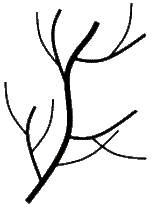
Before pruning
Most pruning of mature plants is to reduce the size, prevent branches rubbing or remove die-back.
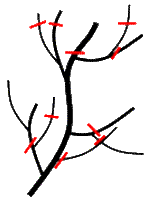
Position of cuts
Cuts of thicker branches are made at the point where they meet smaller ones, the smaller one is left to grow on.
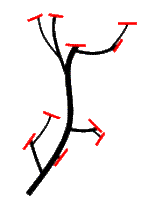
After pruning
Only the smallest twigs are cut straight across to avoid the "stumpy" look. Make all cuts of larger branches at the junction with a smaller branch, leaving the smaller branch to develop.
Rejuvenation
If annual pruning is neglected, naturally prolific shrubs soon accumulate masses of old dead wood in the centre. This can result in excessive size and diminished flowering. Rejuvenate them during their dormant season by first cutting out surplus material such as dead, diseased and crossing stems, and thinning the number of remaining stems by up to a half.
The bush is more likely to survive drastic pruning if the
process is spread out over two seasons.
Shrubs that respond
to severe pruning, such as Ribes and Philadelphus,
may be cut almost to ground level to re-establish a framework
of new shoots. But, if the shrub is elderly and revival is uncertain,
take cuttings as an insurance. Cut out any dead, diseased or
decaying wood from the shrub and remove crossing branches. Remove
half of all the healthy shoots to leave the others room to develop.
Pruning tools - three basic tools suffice for most pruning jobs: secateurs, loppers, and a pruning saw. Keep them sharp for clean cuts and make sure you disinfect them after pruning diseased material.
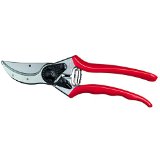
Secateurs Sort of "super scissors" for the garden. An absolute must for all pruning jobs.

Loppers For larger branches. This pair will cope with material up to 25mm (1") in diameter. Loppers are easier and generally safer for many heavier pruning jobs than saws.

Pruning saw. This is used for thicker material, above 25mm (1") in diameter. Saws should also be used for cutting dry and dead material, they are easier to use than loppers for such jobs and give a cleaner cut.
How to prune common plants - quick check list
Roses
Prune in winter or early spring when plants are still dormant. Prune to maintain symmetrical bushes and encourage strong new growth. Cut back all previous years growth as much as one-third its length, I do this in early winter to prevent winter winds and storms rocking the plants or damaging long branches. Remove branches that cross through the center of the plant. Also prune weak and dead stems as required to encourage strong new growth.
Holly
Prune in winter or early spring mostly to shape plants. Cut back wayward branches and prune out weak unproductive dead stems as needed. Holly can be pruned hard and will recover, but slowly... It can be readily pruned to a close shape, I have one holly tree as a 15ft tall slender cone.
Butterfly Bushes (Buddleia)
Butterfly bushes flower in the summer on new spring growth. They can be pruned in late winter or early spring. Pruning encourages new flowers. Also prune out old dead and unproductive branches. The later they are pruned, generally the later they flower, so if you've a few it can be useful to leave some until early spring to extend the flowering season.
Hydrangeas
Hydrangeas fall into two groups. Some you prune in early spring and others after the flowers fade.
Early Spring Pruning - Hydrangeas that flower on new growth. These plants are Climbing Hydrangea, Annabelle, Grandiflora, and PeeGees.
After Flower Pruning - most common - Hydrangeas that flower on last years stems. These include H. macrophylla (Bigleaf), Oak leaf Hydrangeas, Lace caps, Summer Beauty, and Nikko Blue. Pruning should be done when the flowers have faded. Cut back the flowering stems to the strongest pair of new shoots. As plants mature, begin to thin out the oldest woody stems. Remove crowded crossing, broken, or dead branches.Clematis
Clematis can be put in three categories: Spring, summer, and twice flowering.
Spring flowering - Flowers are produced on stems that grew during the previous year. Prune when the flowers are over. Cut back the flowers that are now dead. Prune out any old dead stems while you're at it.
Summer flowering - Plants flower on the current years growth produced in the spring. Cut back stems before new growth begins. Late autumn or early spring is a good time to prune. Cut back about 12 inches of old growth. Each year the plant will grow larger and stronger.
Twice flowering - Plants first flower in spring on stems produced the previous year. There will also be a second flush of flowers in late summer or autumn. In late autumn or very early spring, prune lightly to thin the stems. After the spring flowering, prune more heavily for more healthy stems to develop for the later flowering. After the second showing, prune old flowers away.
All Clematis benefit from being brought down to size, for an established plant at each annual pruning after flowering, cut 1/3rd of the longest stems down to 1-2ft above the ground. This keeps the flowers at a sensible level rather than them getting ever higher and higher up the plant. Remove any dead or diseased stems down to ground level.
Azaleas and Rhododendrons
They can be pruned in winter or early spring, but this will cause the loss of that seasons flowers, so just after flowering is preferred. No additional pruning should be necessary.
Junipers and other conifers
Conifers such as Junipers need very minimal pruning and should be left alone as far as possible which means more care taken to match the plant to the place at planting time. They should be pruned to correct their shape, to accent their form, or to limit their size, during the growing season in mid-summer.
Flowering Shrubs
Prune immediately after flowering. When mature, each year remove around 1/3rd of the oldest stems from the base to ensure a supply of vigorous young stems that will flower more reliably.
Trees
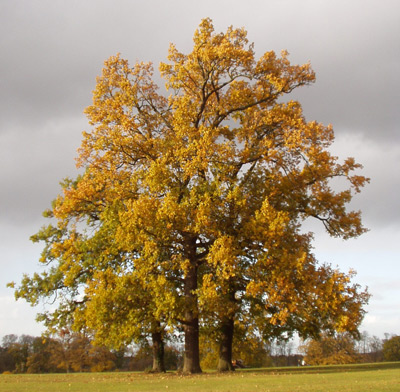 Mature
trees in general don't like being pruned. If you're thinking
of planting a tree, then go for one that you will be happy with
once it has reached its final mature size.
Mature
trees in general don't like being pruned. If you're thinking
of planting a tree, then go for one that you will be happy with
once it has reached its final mature size.
There's nothing quite as sad as a tree that was planted in the wrong place and then later in its maturity had to have some major surgery on large branches that results in a mis-shapen stumpy look.
If you do have to perform major surgery on a tree, first of all find out if you are in a conservation area or if the tree is protected, then consider calling in the professionals. If you're not sure what you're doing, it can be dangerous to you, harmful to the tree and result in a mutilated tree that will possibly never recover during its life-time (or yours).
Most tree pruning should be limited to the removal of dead branches or those that have been torn off by the wind. In both cases cut back to the nearest major junction with another branch. If you look carefully, at every major junction of branches is a raised ridge. This is the natural place where the tree will cut off all contact with the branch if it becomes damaged. Don't cut into or behind this ridge, the tree can then better cope if any disease infects the dead region.
Different trees are best pruned at different times of the yearFruit Trees
Fruit trees: Pomes
A pome is a fruit with pips, most commonly apples and pears. The dormant winter months are an ideal time to prune the over congested spurs from pome fruits. Apples and pears are mainly spur-fruiting trees, meaning that the fruits are produced on short lateral branches some 6-12 inches long. When a tree has been growing for some time, these spurs become over-crowded. The result is a rather untidy looking tree, lots of blossom and lots of small and not very high quality fruit. If you reduce the spurs, then the overall yield won't increase, but you will get a good improvement in the size and quality of the fruit that form.
Remove the older more complicated growth and thin weak stems leaving young vigorous growth behind. It depends on the state of the tree, but you should be aiming to remove about a third of the spur stems. If you repeat this process every year or tow, then the tree will eventually be fruiting only on wood that is no more than a few years old. Remove dead and unproductive branches as needed.
The dormant season is the best time to this for apples and pears before growth starts, when the buds begin to burst it's too late.
Fruit trees: Drupes
A drupe is a fruit with a stone, plums, cherries, peaches and apricots. Drupes on the other hand are pruned in the summer when in growth as winter pruning for these carries a high risk of introducing disease particularly "silver leaf". This also applies to Ornamental Prunus species such as ornamental cherries and almonds.
Plums can be left to their own devices much of the time, prune to keep them in check and so that the plums don't grow farther away from the tree's center. This will put great strain on the branches, causing them to break. July is reckoned to be ideal, but you'll lose pretty much all that seasons crop, immediately after fruiting is fine. Just avoid the dormant season.
Flowering Trees
Flowering trees should be pruned after they have finished flowering. Prune as little as possible. Dead branches, branches that cross in the center, and branches that are unproductive should be pruned out.
Pruning paint - Don't use it!
There are commercially available paints of various types that are sold to paint on the cut ends of large pruned tree branches. Research has shown that these fulfill no useful purpose and in some cases have been shown to actually seal in disease causing organisms and make the stump more likely to rot. More importantly, ensure that the cut is as clean as possible so that there is the minimum area for fungus etc. to enter. If the cut is clean, then it will seal naturally all the quicker. If you first cut is a bit messy or the branch falls and tears the bark, go further down an make a neat and clean second cut.
Copyright 2000 - present. All Rights Reserved | Privacy Policy Statement
